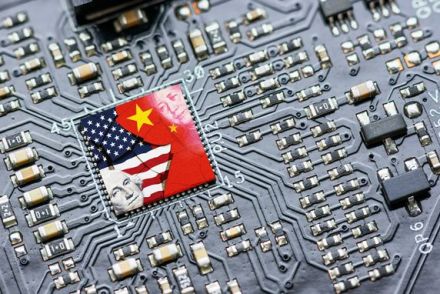The discussion around advanced chips for artificial intelligence, driven by billions in investment, dreams of artificial general intelligence, and marred by political concerns over security, has entered a stage of intense competition between nations.
RELATED: Deepseek will mean more demand for Nvidia chips says fund manager GraniteShares
NVIDIA achieved revenues of over US$80 billion from data center GPUs alone in 2024; however, with significant stock going to nations outside of the US, the US government has mandated stringent measures to reduce this flow, citing national security concerns as the reason. China has been particularly affected by this change, with limited access to not only GPUs but also advanced tools required for manufacturing advanced semiconductor technologies.
Export roadblocks creating necessity for innovation
Whilst these measures create roadblocks for companies across the whole supply chain, they also create the necessity for innovation, with Chinese players demonstrating this already. IDTechEx explores innovations from companies across the AI chips landscape within its semiconductors, computing, and AI portfolio, including a full analysis of the regulations landscape and analysis of international AI chip players, and technologies in the recently released “AI Chips for Data Centers and Cloud 2025-2035: Technologies, Market, Forecasts.”
AI chips for data centers, rely on international collaboration in design, manufacturing, and distribution, however the US has cornered China by restricting this collaboration. These AI processors see increasing demand in data centers, but this comes with high energy consumption and capital costs. Source: IDTechEx
What is the case for artificial intelligence?
Artificial Intelligence (AI) is continuously being adopted into workflows by enterprise and consumers alike, presented as know-it-all generative AI language bots and smart AI agents; however, this is only the final layer of what AI really is.
Behind the screen, and on the other side of the internet, are tens of gigawatts of data centers’ capacity, with millions of GPUs and other AI accelerators populating their racks. AI hardware sees governments and hyperscalers pouring hundreds of billions of dollars into building out AI data centers. These continue to be developed to facilitate the growing size of AI models required to deliver the likes of ChatGPT, Claude, Gemini, and other large AI models.
Demand has outstripped the famous Moore’s Law scaling, with floating point operations per second (FLOPS) increasing at a rate of four and a half times per year since 2010. For perspective, Llama 3.1-405B, a leading AI model from Meta, requires 3.8×1025 FLOPS of training compute, which in turn requires 16,384 NVIDIA H100 SXM5 80GB nodes. This itself takes 2,142 hours with a power draw of 25,280 W to train, which is equivalent to powering 2,085 US households for a year, when running at 40.42% hardware utilization.
This demand for computing is only expected to continue growing, with governments striving to lead in autonomous infrastructure, drug discovery, and military capabilities. IDTechEx forecasts that the AI Chips market will reach US$453 billion by 2030 at a CAGR of 14% between 2025 and 2030.
Pressure on the global semiconductor supply chain
The US puts pressure on the global semiconductor supply chain to limit China and other arms-embargoed countries’ access to advanced chips
Despite US-based fabless chip designers, NVIDIA and AMD, leading in the revenues from AI chip sales, the supply chain is firmly international. Semiconductor manufacture has been dominated by production in Taiwan, with TSMC leading the production of the majority of advanced AI chips. Advanced memory technologies providers have been split between the US and South Korea, with high bandwidth memory (HBM) designed by SK Hynix, Samsung, and Micron Technology.
Lithography equipment, specifically extreme ultra-violet (EUV lithography), is firmly dominated by the Netherlands’ ASML. However, the US has imposed various strategies to limit China’s ability to not only access advanced chips, but also equipment.
Limitations on China’s access to advanced chips
The US’s limitations on China’s access to advanced chips are by no means a new story, but it is a tale that gets more rigid year on year. October 2022, during Biden’s presidency, saw the Bureau of Industry and Security (BIS) introduce controls restricting China’s ability to obtain advanced computing chips, develop supercomputers, and manufacture advanced semiconductors, on the grounds of preventing these technologies from being used for military applications and human rights abuses. The controls were updated to enhance effectiveness and close loopholes in October 2023, which were formed of stricter limitations destined for countries of concern, particularly China.
In December 2024, the BIS further strengthened these controls by adding 24 types of semiconductor manufacturing equipment and three types of software tools to the restricted list. Additionally, 140 Chinese entities were added to the Entity List, requiring special licenses for US businesses to supply them. This move creates a chokehold on Chinese manufacturers to produce advanced chips for AI.
This continued days before Biden stepped down in January 2025, when the Biden administration announced two more rules. One of these was the AI Diffusion Rule, which was more export controls, making a worldwide license requirement for the export of advanced ICs. However, these have since been rolled-back by the Trump administration and have been replaced by individual restrictions on specific chips (e.g., NVIDIA H20, and AMD MI308 chips), and EDA software. A new “Trump AI Controls” rule to replace the Diffusion Rule is expected later in 2025, as well as potential controls on exports to Malaysia, and Thailand, which are diversion routes for China.
The implications for China
For China, these restrictions, as well as ongoing tariff disputes, have been a major roadblock on the road to AI development. NVIDIA has continuously produced chips that comply with trade restrictions, such as the H800 and H20, but these have successively been denied trade to China.
Whilst China may still find ways to dodge these restrictions and stockpile NVIDIA and AMD chips, domestic innovation has ramped up. China’s domestic design and manufacture of advanced chip logic and memory technologies has grown from companies such as SMIC, Huawei, CXMT, Wuhan Xinxin, and Tongfu Microelectronics. Additionally, chip designers such as Huawei, Cambricon, Moore Threads, and others are bringing solutions to market.
Despite this, challenges persist for China, and revenues from China to US firms have also declined since 2022, with client bases shrinking. However, looking beyond this, innovation is thriving, and competition remains strong, driving the progress of new chips from a variety of players.
IDTechEx provides a more in-depth explanation and analysis of the ongoing trade wars, as well as technology breakdowns and trends among AI chip players from the US, China, and other countries, in the report “AI Chips for Data Centers and Cloud 2025-2035: Technologies, Market, Forecasts“.





























